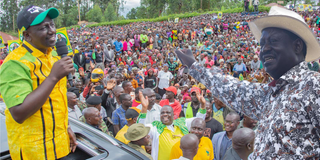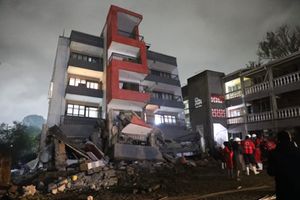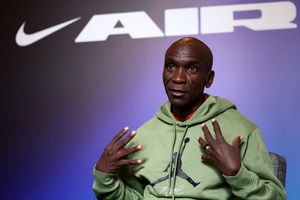60 years of Kenya's electoral mischief

President William Ruto (left) and Azimio leader Raila Odinga.
As President William Ruto begins overhauling the Independent Electoral and Boundaries Commission (IEBC), it seems Kenya is still grappling with the electoral machine – 60 years after independence.
The Judicial Tribunal, led by Justice Aggrey Muchelule, picked to investigate the conduct of the Cherera Four who protested the handling of the tallying of presidential results last August, was treated to behind-the-scenes intrigues and how the IEBC, though perceived to be independent, is usually a site of mischief by various entities out to rig election outcomes.
Azimio la Umoja-One Kenya leader Raila Odinga insists that the four commissioners – Juliana Cherera, Francis Wanderi, Irene Masit and Justus Nyang’aya – did nothing wrong and that the poll results were rigged. That opinion is divided over the independence of a body that should be above board is the continuing story of Kenya’s election machine.
A look at the history of Kenya’s electoral bodies shows a terrain littered with various experiments to either run a clean poll or introduce a vote-manipulation framework. Over the years, there have been both successful and unsuccessful attempts to steal the election, and mischievous conduct, too. The last presidential election faced the same predicament, Muchelule’s tribunal observed.
Supervisor of Elections
What we find from history is fascinating. After Independence in 1963, Attorney-General Charles Njonjo would single-handedly appoint the Supervisor of Elections – a small office within the AG’s chambers. Njonjo was deemed the custodian of the public good, and he had the district commissioners and the entire public administration, who played a central role in organising joint campaign meetings for candidates to sell their agenda. As it were, Njonjo, and later the provincial administration, would interfere with elections, leading to a poll culture of deceit that has become ingrained into the entire government machinery.
Just before Independence, the elections were conducted by F. P. Derrick, who was appointed by the Governor in 1960 to oversee Kenya’s transition to Independence. It was a tricky ballot since, in those days, the vote was weighted: a person with a university degree or civil servant earned more points than an ordinary citizen. After Independence, the electoral body did not enjoy autonomy from the central government, given that the AG was an appointee of the President – an interested party in the outcome of an election.
Elections on May 18, 1963 were carried out amidst fear that violence would erupt in the race between the rival Kenya African National Union (Kanu) and the Kenya African Democratic Union (Kadu). This election was supervised by Rogers Wilkinson, appointed by the acting Governor, Sir Eric Griffith-Jones. After Kanu won the race and Jomo Kenyatta was appointed Prime Minister, he retained Wilkinson until 1965, when Donald Owuor was appointed the first African supervisor of elections.

Former President Daniel arap Moi (left) and former Attorney-General Charles Njonjo .
But Owuor would not last, for Njonjo did not believe that he would be impartial enough to conduct the ‘little by-elections’ triggered by the defection of Kanu members of Parliament to Jaramogi Oginga Odinga’s Kenya People’s Union (KPU).
So Njonjo removed Oduor and replaced him with Darius Mbela. No reason was given, but it is suspected that Njonjo linked him to the KPU. Therefore, Mbela’s appointment in 1966 came at a time when the ruling party, Kanu, was going through serious internal wrangles as ideological wars between a faction led by Vice-President Odinga on one side and Kanu Secretary-General Tom Mboya on the other raged. While Kanu had used the defection tactic to increase its numbers in Parliament from the Kadu side without a by-election in 1964, Odinga’s 1966 attempt to use the same tactic and build his KPU was thwarted by Njonjo, who asked Parliament to change the law and stop members from switching parties on the floor of Parliament without going through a by-election.
Thus, Darius Mbela conducted the murky little by-elections of June 12, 1966 that followed the defection of Odinga and allies to the KPU. During that election, Kanu won eight senate seats to KPU’s two and 12 House of Representative seats to KPU’s seven.
KPU accused Mbela of rigging the election in favour of Kanu. Shortly afterwards, Mbela was appointed a Permanent Secretary and replaced by Norman John Montgomery, whose term ran from 1967 to 1980. Montgomery would supervise the 1969, 1974, and 1979 post-Kenyatta elections; he quit quietly in protest over rigging in the 1979 poll.
But rigging had not started in 1979. During the 1974 elections, and under Montgomery’s watch, the government barred a candidate for the Nyandarua North parliamentary seat, Josiah Mwangi Kariuki, from campaigning (it was alleged he was inciting people), and forced him to print posters distributed by his wife which read: “If this man has done nothing for you don’t elect him.” Kariuki won the seat with 16,000 votes to his rival’s 3,000.
Rigging
The following year, 1975, he was assassinated. With Jomo Kenyatta’s death in August 1978, the electoral machine was set for an overhaul as Daniel arap Moi wanted to have control of it. Although rigging was prevalent before Kenyatta’s death, it had not reached notoriety levels. The central government tried to stop its critics from winning parliamentary seats – although some radicals still managed to get into the House.
In 1979, Moi used the electoral machine to eliminate powerful Kenyatta-era politicos, causing an embarrassed Montgomery to resign in protest against management of polls in Baringo, Nandi and Elgeyo Marakwet, where Moi’s henchmen were elected unopposed.
Montgomery was replaced by Zachary Nyarango, a close ally of the powerful Simeon Nyachae, who had just left the provincial administration for the president’s office. During his tenure, Nyarango witnessed some of the most tumultuous elections. It was he who supervised the 1983 snap general election that saw the fall of all those associated with Njonjo. While that election was, by rigging standards, still regarded one of the worst, it hardly measures up to the 1988 queue-voting elections supervised by J. P. Mwangovya, appointed in 1987 by Moi.
In the queue-voting system, some MPs were deemed elected unopposed if they garnered more than 80 per cent of the votes during nominations. But this was marred by claims of rigging, with protests that numbers had been changed after the physical count, though there was no chance of verification.
Mwangovya’s tenure would last until 1991, when Moi appointed Justice Zacchaeus Chesoni chairman of the Electoral Commission of Kenya as the country prepared for its first multi-party elections. While the opposition had demanded various reforms, the parties agreed on minimum changes that included an expansion of the commission to include opposition sympathisers.
But still, the provincial administration played a key role in managing elections, in the process frustrating the opposition candidates. Chesoni would be blamed by the opposition for rigging the polls in favour of Kanu and for swearing Moi in as president at dawn in a race that had pitted him against opposition candidate Kenneth Matiba.
In 1993, a Constitutional amendment was made that increased the number of commissioners to 12, but more was needed to restore Kenyans’ lost faith in the ECK. In 1997, following the so-called Inter-Parliamentary Parties Group (IPPG) reforms, the number of Commissioners was increased to 22 to give political parties a chance to nominate their representatives. Yet again, Moi won the presidency, and the ECK was accused of being swayed by Kanu.
Independent secretariat
The ECK established an independent secretariat in 1998 – away from the Attorney-General’s chambers – which functioned until 2007, when it was disbanded following chaotic presidential polls. It was by that time headed by Samuel Kivuitu, who had to swear in President Kibaki for a final term late in the evening.
Also created by a 2008 Constitutional Amendment was the Interim Independent Boundaries Review Commission (IIBRC) chaired by politician Andrew Ligale to stop the political gerrymandering of previous years, when politicians used their powers to shape constituency boundaries.
The IEBC, formed in 2011, was supposed to cure the electoral ills of former years, but the first commission, led by lawyer Isaack Hassan, immediately ran into trouble from politicians who wanted to pull it down. In 2017, the body saw a change of guard with the entry of Wafula Chebukati some seven months before elections. But Chebukati’s handling of the poll that saw the Supreme Court order a repeat presidential contest indicated that Kenya was still far from experiencing smooth elections.
As pressure mounted on Chebukati to quit, some of his commissioners – Consolata Nkatha, Paul Kurgat, Roselyn Akombe and Margaret Mwachanya – left in protest. And in the 2022 election – another four would differ with him, triggering a falling-out, a tribunal and resignations.
As Kenyans search for a new team to run elections, the question will be whether we have learned any lessons from our history.
[email protected]; @johnkamau1





